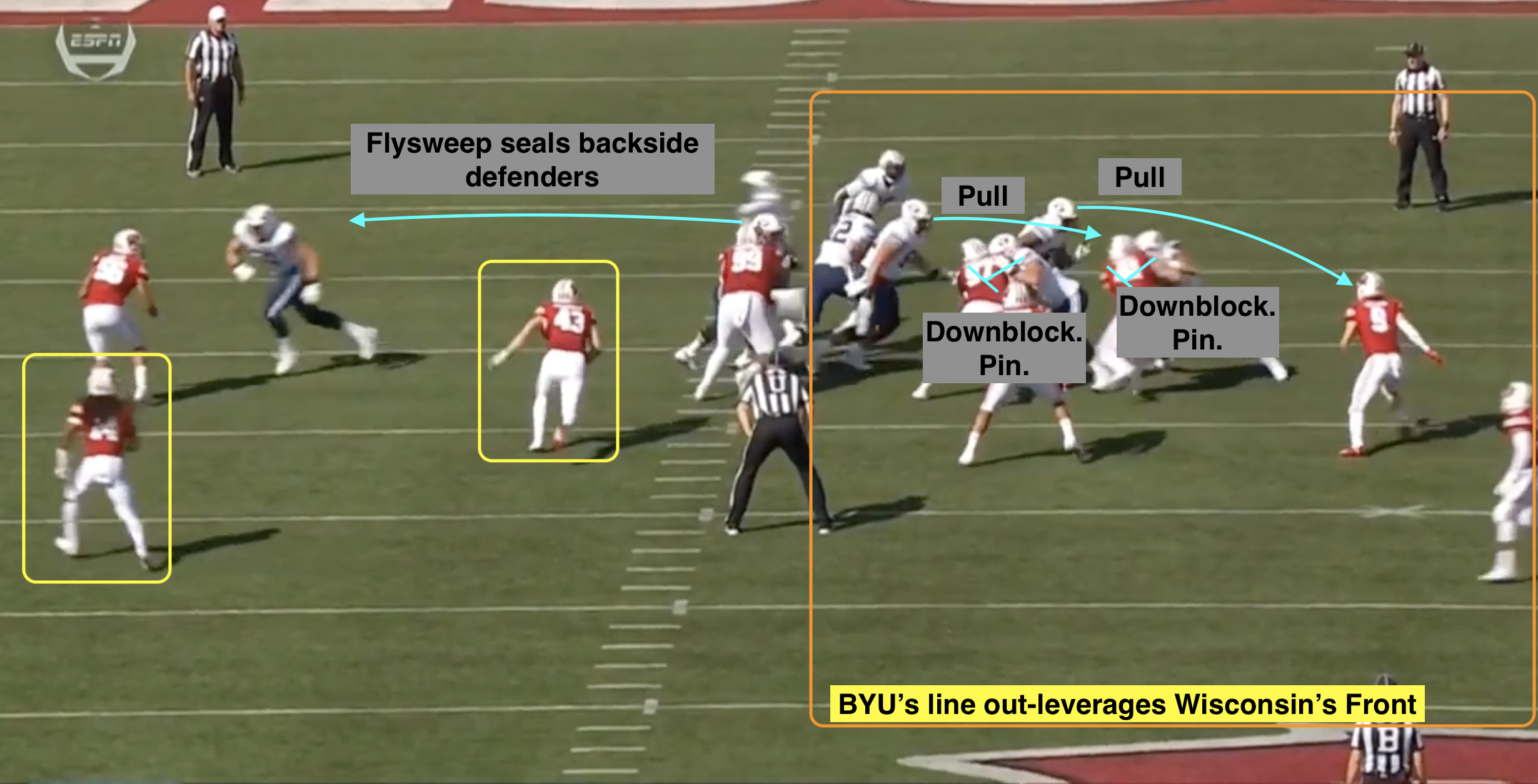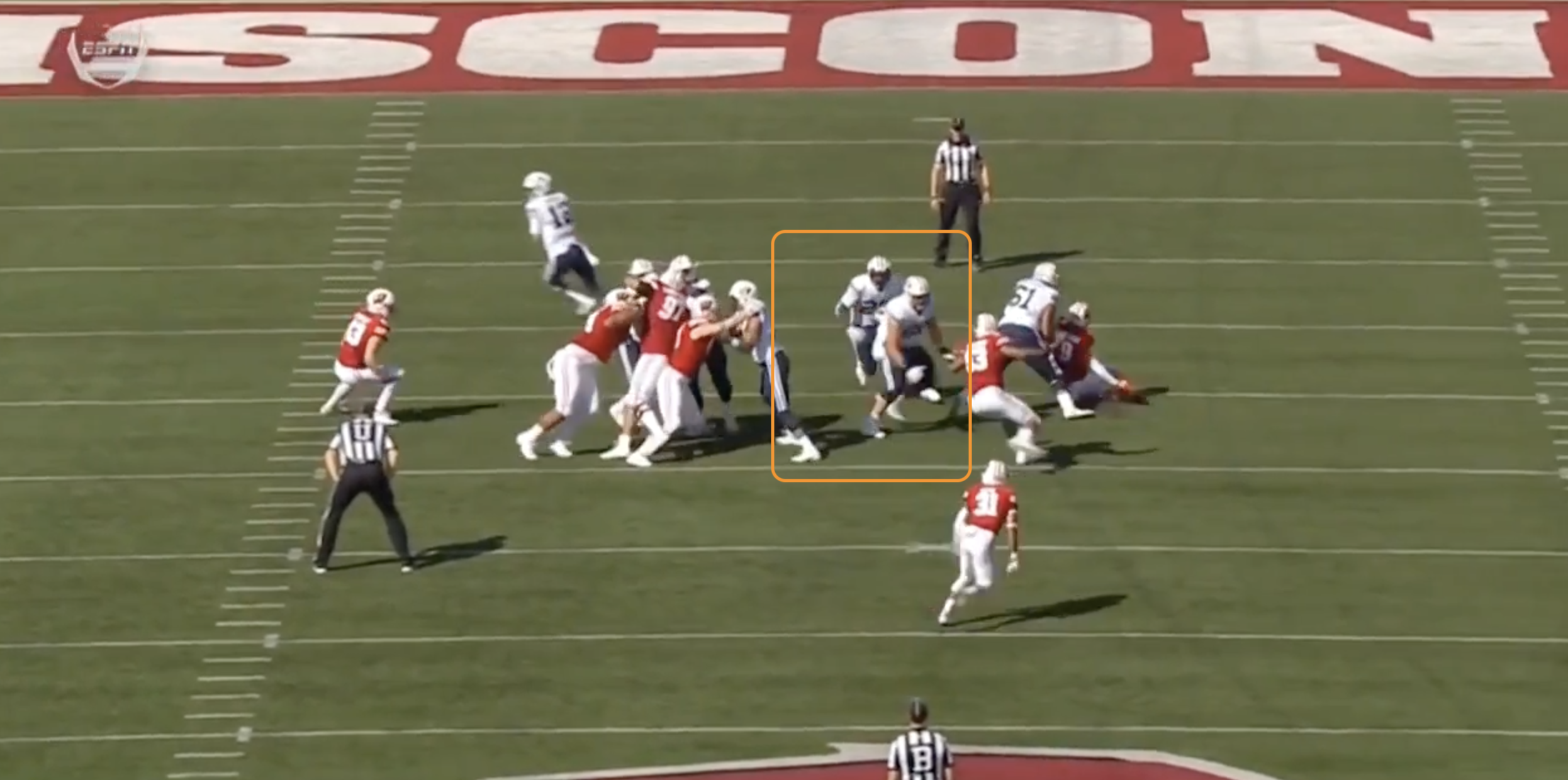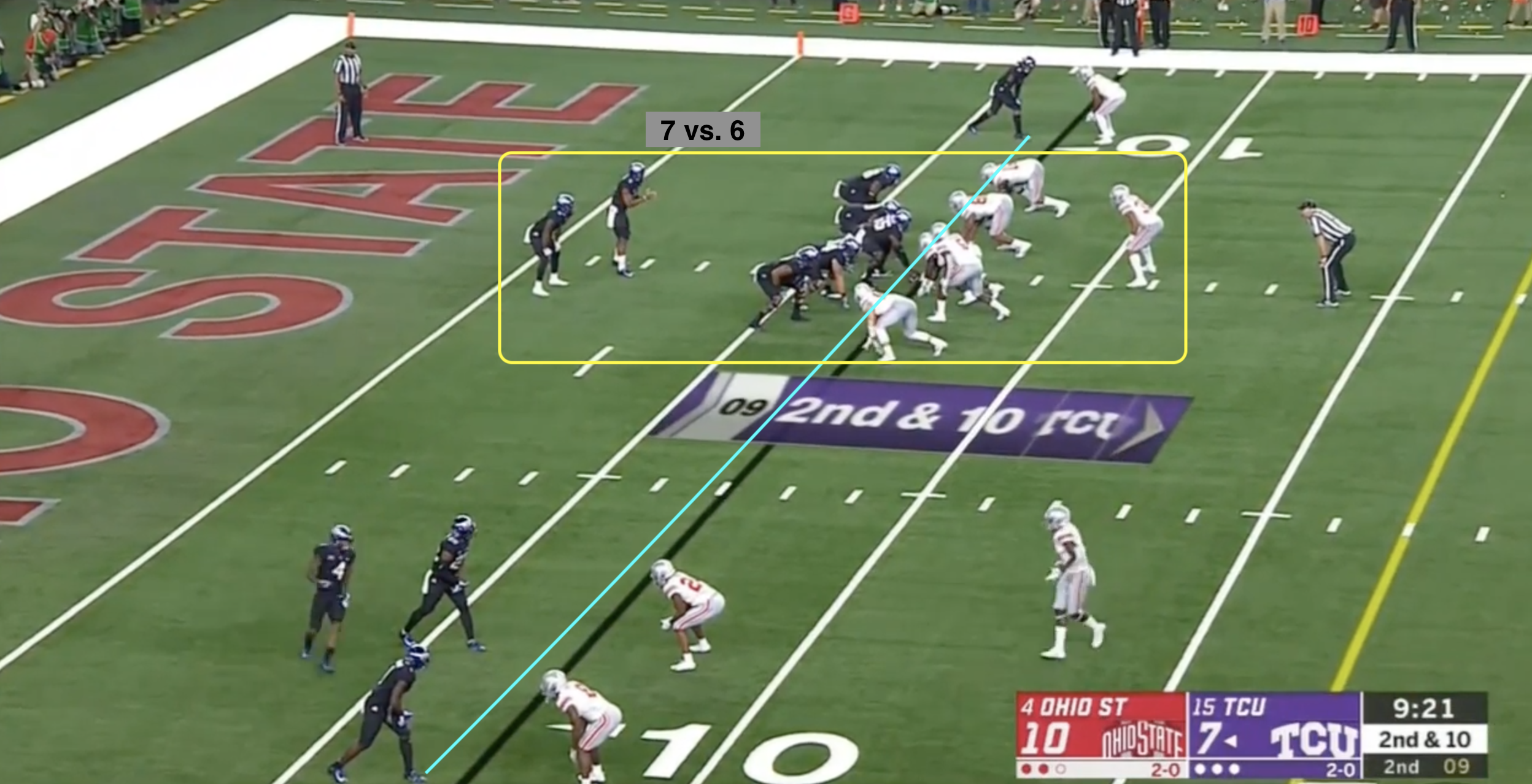Week 3 Film Study: BYU runs past Wisconsin, Haskins keeps impressing
Here's a look at some of the more intriguing film-related developments from Week 3 of the college football season.
BYU's creative run game
BYU sneakily runs one of the most creative rushing attacks in the country. New offensive coordinator Jeff Grimes was on the ill-fated Matt Canada staff at LSU last year, and the influence is clear.
Grimes mimics Canada's confuse-and-clobber style. There are all kinds of funky motions and shifts, and a heavy emphasis on fly sweeps to help level out the run game - particularly crucial if you lack a rushing threat at QB.
BYU did most of its damage against Wisconsin on the ground - the offense churned out 6.8 yards per carry though quarterback Tanner Mangum finished with a measly 89 yards through the air - and the Badgers spent Saturday afternoon chasing shadows. Grimes crafted designs to out-leverage Wisconsin's front, forcing second-level defenders to figure out where the ball was before they could drive downhill.
Everything was predicated on the fly sweep. Grimes ran some variation of it out of every conceivable pre-snap look: heavy, condensed looks; spread formations; unbalanced lines; bunched sets; two-back formations. Regardless, a receiver or back would flash across the formation, either receiving the handoff or serving as some tasty window dressing:
The goal here is twofold. If the ball is given, Grimes hopes the outermost defender (the force defender) will cheat inside, gifting the runner an alley.
If it's a ghost motion (the motion man doesn't get the ball), the offense hopes the reverse occurs and the defender maintains his width, freeing up more space inside. Essentially, the defender is taken out of the play - blocked - without being touched.
There are an awful lot of bodies to sort through, and defenders can't get much of a pre-snap clue from film study, since all the different designs look the same initially. Defenders have to consider a bunch of different possibilities at once, and it becomes a read-and-react play.
Wisconsin's linebackers couldn't cope. They consistently vacated their gaps, firing to one spot while the ball went to another:
The sheer volume of run designs tagged onto the base look (the fly sweep) is flat-out wicked. The dastardliest was tagging a pin-pull sweep back toward the motion man:
Talk about moving parts.
There, the motion-man is window dressing. Grimes wanted Wisconsin's backside defenders to widen their positions, taking them farther from the true point of attack. It worked.
The jet motion flew across the formation, sealing the backside linebacker and a spinning safety. The frontside of BYU's line down-blocked Wisconsin's defensive linemen, pinning them towards the middle of the field. A pair of backside linemen wrapped around, helping out-leverage a Wisconsin front that was left flat-footed.

By the time Wisconsin's middle linebacker and deep safety figured out who had the ball, it was curtains.

Grimes did an excellent job of sticking in attack mode. He never allowed Wisconsin's front to dictate the rules of engagement. Simple switches like running an unbalanced line confused the defense's gap responsibilities, helping the Cougars pick up important first downs:
The Badgers spent four quarters trying to figure out a solution. Their linebackers crept closer to the line of scrimmage. The defensive line slanted. ‘Backers started shooting gaps. None of it worked.
Of course, Grimes had fresh tags to take advantage. He knew what the first couple of adjustments would be - more aggressive defensive calls - and ran some play-action designs out of the same pre-snap looks. They didn't work. BYU's receivers couldn't escape the Badgers' sticky coverage.
The Cougars hit one explosive downfield ball: a double pass, with the Wisconsin defense driving on what looked like a screen pass tagged onto a fly sweep.
Paul Chryst's side undoubtedly has more talent than BYU, but the coach and his staff got out-schemed Saturday. Grimes deserves an awful lot of credit for the upset, and the Cougars executed their brilliant plan at a high level.
Ohio State's Jimmies and Joes overcome Xs and Os
Gary Patterson's side almost pulled off the upset over Ohio State, but couldn't quite get across the line, even though TCU out-schemed the Buckeyes on both sides of the ball for three quarters.
Patterson's team did an excellent job of keeping the Buckeyes off-balance. The Horned Frogs passed on rushing downs and ran on passing downs. They used a lot of pre-snap movement (motions and shifts) to reset the line of scrimmage and make it a competition outside the tackle box, where a game becomes more about one-on-one matchups in space.
Few teams in the country can compete with Ohio State's defensive front. Clearing out the box through formations and receiver splits is a must. TCU made a conscious decision to clear out the box and run the ball when OSU rotated in its pass-rushers, typically on second and third downs.
Above, against a lighter five-across front, TCU spread its formation out. On one side, the team ran a bunch look outside the formation. On the other, the isolated receiver was in a plus-split, pressed up toward the sideline.
When you add the threat of the quarterback run, TCU had seven players in the box matched up to the Buckeyes' six, including a hybrid linebacker, better suited to chase players around in coverage.

TCU's running back squeezed through the line of scrimmage. He ran 35 yards downfield untouched before making the safety miss and scoring a 93-yard touchdown.
It seems obvious, but coaches are often loath to let the opposition dictate their down-to-down play calls. They install their game plan and they want to run what they do best. Patterson is different. Whenever the Buckeyes loaded up with their run-down personnel - typically a strike-front - they threw the ball:
It was the perfect plan, and for three-and-a-half quarters, TCU looked poised to pull off the upset.
Then the team shot itself in the foot with penalties, special-teams errors, and dopey decisions. In a six-minute span, Patterson's guys wiped out all their good work.
Ohio State turned the screws. Ryan Day's offense ran more athletes-in-space concepts rather than the slower-to-develop downfield passing concepts that have been a hallmark of the Buckeyes' attack since Kevin Wilson arrived. Dwayne Haskins was forced to push the ball into space, getting it out of his hands more quickly:
There's only so long you can withstand such a battery of five-star players, and the Buckeyes' talent eventually ground TCU down. OSU's offensive line began to get a consistent surge. Running back J.K. Dobbins routinely got to the second level untouched, and once there, he's one of the deadliest players in the game.
It was the Buckeyes' defensive front, though, that made the greatest impact. At some point, the Jimmies and Joes become the difference.
Even with Nick Bosa out due to an injury, the Buckeyes' defensive line is as gifted as any in the country, and Dre'Mont Jones stepped up. He's a ridiculous athlete with a great get-off, extendo arms, and a sky-high football IQ. He sees everything that is possible. And with arms that long, almost everything is possible.
Jones took over the game from late in the third quarter. First, he grabbed a pick-6:
Jones caved in the inside of TCU's offensive line. He beat his blocker to his set point, disrupting the timing of the shovel option. TCU's quarterback should have swallowed the play, and he didn't. Jones leaped in front of the running back, grabbed the ball, and led a convoy of bodies to the end zone.
He followed that up with a sack, turning second-and-long into third-and-forever:
And just like that, the game was essentially over.
You can scheme all you like. By rights, the TCU staff deserved to clinch that game. But some teams just have better players than you, and there's not much you can do about it.
Dwayne Haskins: a different kind of OSU quarterback
Not your typical Urban Meyer/Ohio State quarterback, Haskins can do a little bit of everything.
He's an on-time, rhythm thrower, and he's also a nuanced passer who understands how to attack specific coverages and leverages. He does an excellent job of mixing up his trajectories and velocities. He has a good arm and quick release, but not every throw has to come out like a rocket.
Haskins impressed when thrust into action against Michigan last year, and appeared to have improved in the first two weeks of this season against poor-quality opponents. TCU represented his first real test since that feisty Don Brown defense in Ann Arbor, and Haskins passed with flying colors.
His numbers didn’t pop in the first half, as he was a victim of dropped balls and an annoying early game script. Ohio State looked to go deep over and over again, hoping for a home-run ball to ignite the offense and back up TCU's defense, also freeing the Buckeyes' run game. But Haskins didn’t have enough time to deliver most of the throws. When he did, he delivered a kill shot:
Haskins had all the time necessary, and he made TCU pay.
Gary Patterson has made a living from constructing imposing defenses. They aren't all that creative - there isn't a raft of match principles or spinning safeties or a crazy blitz - but Patterson condenses the field with four deep defenders and doubles the most important receiver. It typically takes all the rhythm out of an offense, particularly one that wants to strike downfield as often as OSU's.
Credit to Haskins for not getting flustered. He was at his most impressive when stuck in empty, where the quarterback must account for any blitzing defenders or protection issues. The ball has to come out fast. Field vision is at a premium.
It doesn't get much better than that. Haskins knew where he wanted to go with the ball as soon as he identified the slot corner swooping on off the edge. He knew his protection was solid, and his left tackle was free to slide over and pick up the extra rusher. The trick, then, was to hold the middle-of-the-field safety until he could nail K.J. Hill in the end zone.
The MOF safety doubled the OSU receiver releasing from the top of the bunch formation set into the boundary. Haskins wanted to go to his iso guy on the opposite side of the field. He flashed his eyes toward the middle of the field, holding that single deep safety in place, before hitting Campbell with the back-shoulder throw.
Haskins still brings the dynamic element to the offense that Meyer craves - he's big and he can move. He isn't an agile runner, but he's quick enough and large enough to be a problem when he keeps the ball on option elements:
But Haskins has a little something extra. J.T. Barrett struggled when placed under pressure. He wanted to bail out of the pocket at the first sign of danger. Not Haskins. He doesn't want to use his legs - he wants to stand in and carve open the defense with his eyes and arm:
Haskins offers more schematic diversity than Meyer's previous signal-callers, both in terms of formations and play designs. With the level of talent surrounding the quarterback, good luck stopping this unit.